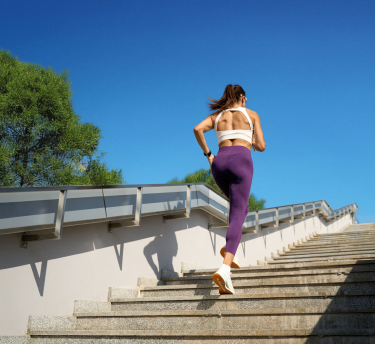A runny nose — also known as rhinorrhoea — is excess drainage produced by the nose and surrounding mucous membranes; it can be thin and clear or thick mucus.


How to Exercise with Allergies
Working out with allergies can be challenging, but it doesn’t mean that you need to be trapped indoors all season long. With the right tools and allergy management tips, exercising outdoors with seasonal allergies is possible. Learn how to enjoy your favourite outdoor activities and achieve your fitness goals — without being slowed down by sneezing, a runny nose, watery eyes, or an itchy throat.
There are certain times of the year that especially motivate us to head outside and enjoy the beautiful temperatures, warm sun, and refreshing breeze. When the weather is at its best, it creates the perfect opportunity to take advantage of outdoor activities that support a healthy lifestyle, such as bike riding, hiking, jogging, or yoga in the park.
Unfortunately, these months of the year can also coincide with peak allergy seasons, such as the spring and summer, which can cause allergy symptoms that may slow you down and make exercising outdoors a challenge. Keep reading to discover some techniques for exercising with allergies beyond the gym — including tips to keep seasonal allergy symptoms under control — so that you can continue enjoying your favourite outdoor activities.
Should You Exercise with Seasonal Allergies?
When itching, sneezing, and sniffling leave you feeling like you can’t give it your all, it’s normal to wonder whether working out with seasonal allergies is a good idea—especially when it means immersing yourself in pollen season triggers like grass pollen and eucalypt pollen (and ragweed pollen if you’re a NSW local). However, physical activity brings with it numerous benefits for your mental and physical health, from improving your cardiovascular health to reducing stress.1 Therefore, it’s important not to give up on exercise entirely during allergy season, but rather, focus on finding the right tools and workouts to suit your needs.
Does Working Out Help with Allergies?
With such an abundance of health benefits, regular exercise is one of the best steps you can take to support good health. And fortunately, everyone can benefit from the right type of personalized exercise routine — regardless of gender, age, physical ability, or other factors. Although exercise may help to better equip your body to deal with allergy symptoms, by improving cardiovascular health and overall health, it’s also important to remember that the relationship between allergies and exercise is an individual one that varies from person to person. Seasonal allergies are caused by numerous triggers that can affect each person differently. A doctor or allergist is always best suited to offer a proper diagnosis and answer any questions you may have about exercise and allergies.
What’s the Best Outdoor Exercise for Seasonal Allergies?
Knowing your allergy triggers (and how to best manage them) can help you live your greatness by choosing the right types of “allergy-friendly” exercises during allergy season. For example, if your triggers are largely airborne (such as ragweed pollen), you might enjoy exploring some static, low-speed activities where there will be less allergens flying towards your face. If grass triggers allergy flare-ups during pollen season, you can opt for grass-free exercises like swimming or surfing instead. With a bit of creativity, there are plenty of activities to enjoy outdoors that won’t leave you feeling limited or left out.
Seasonal allergies can also trigger shortness of breath, which are caused by a tightening of the airways as you inhale allergens.2 In cases like this, it may be ideal to stick to medium- to low-impact activities that focus on light, gradual movements, like brisk walking, hiking, recreational biking, pilates, or yoga. Vigorous outdoor exercises that cause heavy breathing can potentially worsen symptoms by simply causing you to push yourself too hard. If you suspect you may have more serious conditions related to your allergies, consult with your doctor or an allergist.
Remember to Include a Warm-up and Cool-down
Give your body a chance to acclimatise to the outdoor environment by always including a proper warm-up (for approximately 6–10 minutes), followed by a cool-down period when your workout is over. If you’re an allergy sufferer who is unsure of your health status, are pregnant, facing other health complications, or just beginning your exercise journey, it’s always best to speak with a healthcare professional before starting a new exercise program to ensure it’s the right step for your well-being.
Tips for Exercising with Seasonal Allergies
Having seasonal allergies doesn’t mean that your workout regimen has to be strictly limited to a gym or your living room. If you suffer from outdoor allergies, following the right precautions — such as knowing when and where to exercise, for instance — can help. Below, we’re sharing some tips to help you stay ahead of seasonal allergies so that you don’t have to give up on exercising outdoors.
1. Identify your allergy triggers
The most common outdoor allergy triggers in Australia include tree, grass, and weed pollen. Understanding which outdoor triggers are causing your seasonal allergy symptoms is key. Your doctor can help you put together a list of triggers, based on allergy test results, that will help you adjust your outdoor workouts most effectively. That way, you can plan to exercise indoors on days when your known triggers will be at their highest levels, and head outside when the chance of an allergy flare-up is lower.
2. Check the weather before heading outside
Always check the forecast before heading outside. Fluctuations in humidity, wind, and temperatures, as well as climate change in general, can all impact pollen counts (how much pollen is in the air at a given time). On days when pollen counts are at their highest — such as dry and windy days when pollen travels easily through the air — you may want to opt for indoor exercise instead. According to HealthDirect, the best time to be outdoors for pollen allergy sufferers in Australia is usually mid-morning to mid-afternoon and after rain, avoiding windy or early morning hours when pollen counts peak.3
3. Choose the best time for your workout
You’ll also want to consider the optimal time for your workout. Typically, the worst time of the day for pollen is after midday.3 An evening or early-morning workout may be a good option for seasonal allergy sufferers, when dew lowers pollen counts.
4. Take allergy medication as directed
Taking allergy medicine consistently and as directed — per the product’s label or by a healthcare provider — at the first sign of symptoms can help relieve seasonal allergies when exercising outdoors. Your health care professional can help you choose the best antihistamine to support your preferred outdoor activities.
5. Wear protective clothing
Try adding some protective items to your exercise attire to help prevent allergens from entering your eyes, nose, or mouth, such as wraparound sunglasses or a hat. In some cases, when direct exposure to allergens can’t be avoided during physical activity (such as when mowing the lawn), a pollen mask may be helpful. These items can act as barriers and help lower your exposure to seasonal allergy triggers during your outdoor activities.
6. Be flexible and listen to your body
It’s best to remain flexible and tuned into your symptoms before stepping outside to exercise. This can include incorporating creative ideas, such as doing half of your workout indoors and the less strenuous half outdoors, for example. It’s all about finding the right strategies that will make your outdoor exercise routine work for you, and taking it easy on days when you’re not feeling your best due to allergy symptoms.
7. Take a shower after your workout
It’s advisable to shower as soon as possible after exercising in order to eliminate allergens from your body and hair. Washing your workout clothes after exercising can also help remove allergy triggers that collect on your clothing and help prevent a post-workout reaction. This also includes thoroughly wiping down any mats or equipment you may have taken with you outdoors.
If you’re looking for short term relief from your allergy symptoms, find out which Telfast product may be right for you.
Related articles